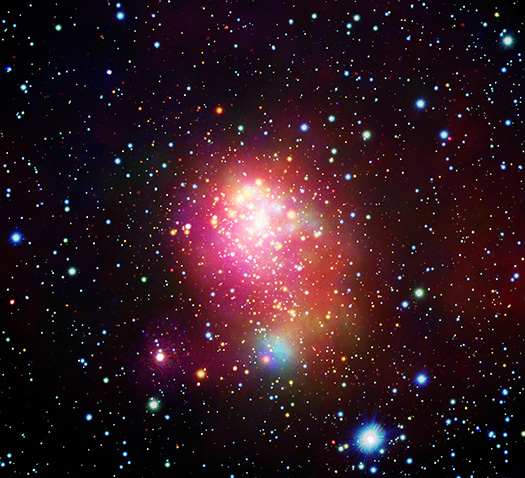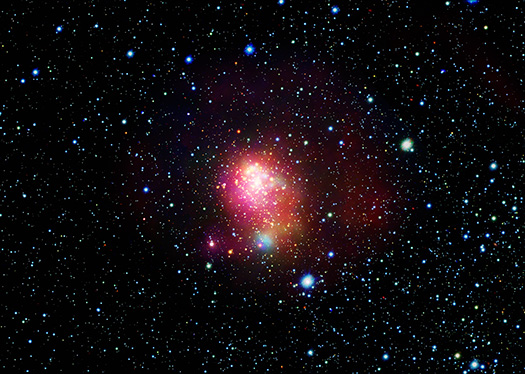'Super' Star Cluster Shines in New Look From NASA's Chandra

Westerlund 1
Credit: X-ray: NASA/CXC/INAF/M. Guarcello et al.; Optical: NASA/ESA/STScI;
Image Processing: NASA/CXC/SAO/L. Frattare
Westerlund 1 is the biggest and closest “super” star cluster to Earth. New data from NASA’s Chandra X-ray Observatory, in combination with other NASA telescopes, is helping astronomers delve deeper into this galactic factory where stars are vigorously being produced.
This is the first data to be publicly released from a project called the Extended Westerlund 1 and 2 Open Clusters Survey, or EWOCS, led by astronomers from the Italian National Institute of Astrophysics in Palermo. As part of EWOCS, Chandra observed Westerlund 1 for about 12 days in total.
Currently, only a handful of stars form in our galaxy each year, but in the past the situation was different. The Milky Way used to produce many more stars, likely hitting its peak of churning out dozens or hundreds of stars per year about 10 billion years ago and then gradually declining ever since. Astronomers think that most of this star formation took place in massive clusters of stars, known as “super star clusters,” like Westerlund 1. These are young clusters of stars that contain more than 10,000 times the mass of the Sun. Westerlund 1 is between about 3 million and 5 million years old.
This new image shows the new deep Chandra data along with previously released data from NASA’s Hubble Space Telescope. The X-rays detected by Chandra show young stars (mostly represented as white and pink) as well as diffuse heated gas throughout the cluster (colored pink, green, and blue, in order of increasing temperatures for the gas). Many of the stars picked up by Hubble appear as yellow and blue dots.

Only a few super star clusters still exist in our galaxy, but they offer important clues about this earlier era when most of our galaxy’s stars formed. Westerlund 1 is the biggest of these remaining super star clusters in the Milky Way and contains a mass between 50,000 and 100,000 Suns. It is also the closest super star cluster to Earth at about 13,000 light-years.
These qualities make Westerlund 1 an excellent target for studying the impact of a super star cluster’s environment on the formation process of stars and planets as well as the evolution of stars over a broad range of masses.
This new deep Chandra dataset of Westerlund 1 has more than tripled the number of X-ray sources known in the cluster. Before the EWOCS project, Chandra had detected 1,721 sources in Westerlund 1. The EWOCS data found almost 6,000 X-ray sources, including fainter stars with lower masses than the Sun. This gives astronomers a new population to study.
One revelation is that 1,075 stars detected by Chandra are squeezed into the middle of Westerlund 1 within four light-years of the cluster’s center. For a sense of how crowded this is, four light-years is about the distance between the Sun and the next closest star to Earth.
The diffuse emission seen in the EWOCS data represents the first detection of a halo of hot gas surrounding the center of Westerlund 1, which astronomers think will be crucial in assessing the cluster’s formation and evolution, and giving a more precise estimate of its mass.
A paper published in the journal Astronomy and Astrophysics, led by Mario Guarcello from the Italian National Institute of Astrophysics in Palermo, discusses the survey and the first results. Follow-up papers will discuss more about the results, including detailed studies of the brightest X-ray sources. This future work will analyze other EWOCS observations, involving NASA’s James Webb Space Telescope and NICER (Neutron Star Interior Composition Explorer).
Category:
- Log in to post comments
